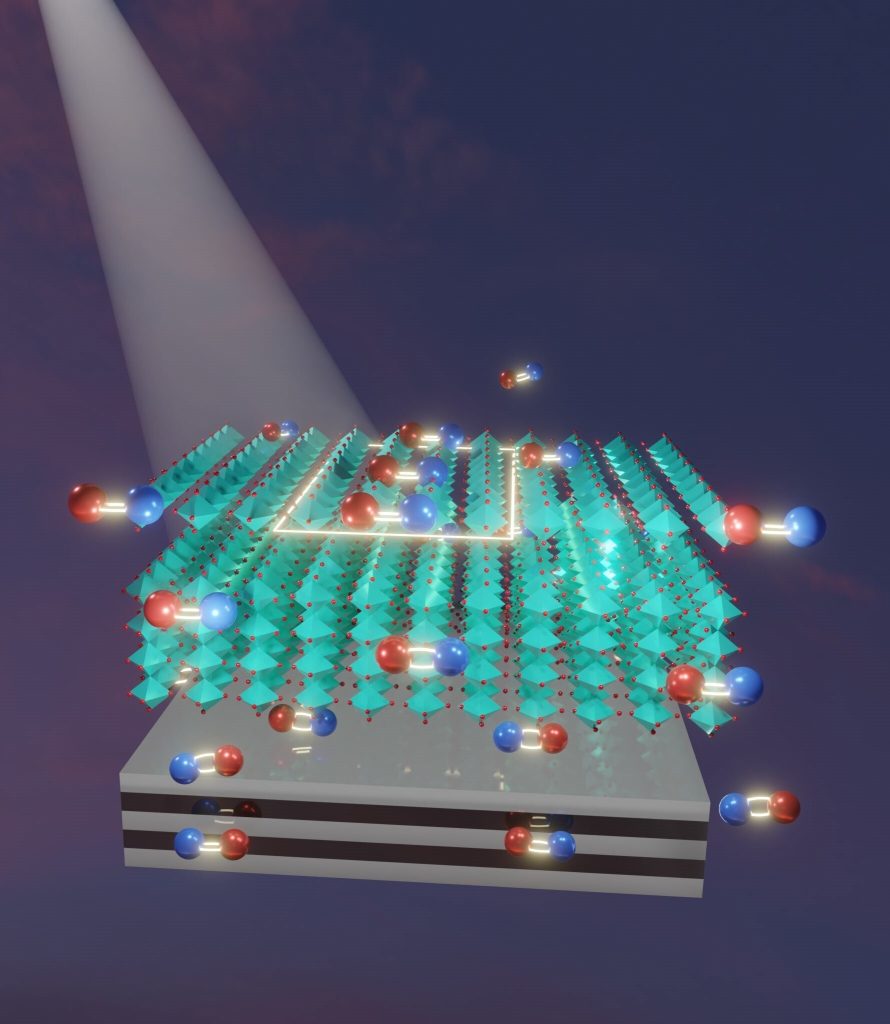This illustration from the Guo Lab shows the interaction between a perovskite material (cyan) and a substrate of metal-dielectric material. The red and blue pairings are electron-hole pairs. Mirror images reflected from the substrate reduce the ability of excited electrons in the perovskite to recombine with their atomic cores, increasing the efficiency of the perovskite to harvest solar light. Credit: Chloe Zhang
Silicon, the standard semiconducting material used in a host of applications—computer central processing units (CPUs), semiconductor chips, detectors, and solar cells—is an abundant, naturally occurring material. However, it is expensive to mine and to purify.
Perovskites—a family of materials nicknamed for their crystalline structure—have shown extraordinary promise in recent years as a far less expensive, equally efficient replacement for silicon in solar cells and detectors. Now, a study led by Chunlei Guo, a professor of optics at the University of Rochester, suggests that perovskites may become far more efficient.
Researchers typically synthesize perovskites in a wet lab, and then apply the material as a film on a glass substrate and explore various applications
Guo instead proposes a novel, physics-based approach. By using a substrate of either a layer of metal or alternating layers of metal and dielectric material—rather than glass—he and his co-authors found they could increase the perovskite’s light conversion efficiency by 250%.
Their findings are reported in Nature Photonics.
“No one else has come to this observation in perovskites,” Guo says. “All of a sudden, we can put a metal platform under a perovskite, utterly changing the interaction of the electrons within the perovskite. Thus, we use a physical method to engineer that interaction.”
Novel perovskite-metal combination creates ‘a lot of surprising physics’
Metals are probably the simplest materials in nature, but they can be made to acquire complex functions. The Guo Lab has extensive experience in this direction. The lab has pioneered a range of technologies transforming simple metals to pitch black, superhydrophilic (water-attracting), or superhydrophobic (water-repellent). The enhanced metals have been used for solar energy absorption and water purification in their recent studies.
In this new paper, instead of presenting a way to enhance the metal itself, the Guo Lab demonstrates how to use the metal to enhance the efficiency of perovskites.
“A piece of metal can do just as much work as complex chemical engineering in a wet lab,” says Guo, adding that the new research may be particularly useful for future solar energy harvesting.
In a solar cell, photons from sunlight need to interact with and excite electrons, causing the electrons to leave their atomic cores and generating an electrical current, Guo explains. Ideally, the solar cell would use materials that are weak to pull the excited electrons back to the atomic cores and stop the electrical current.
Guo’s lab demonstrated that such recombination could be substantially prevented by combining a perovskite material with either a layer of metal or a metamaterial substrate consisting of alternating layers of silver, a noble metal, and aluminum oxide, a dielectric.
The result was a significant reduction of electron recombination through “a lot of surprising physics,” Guo says. In effect, the metal layer serves as a mirror, which creates reversed images of electron-hole pairs, weakening the ability of the electrons to recombine with the holes.
The lab was able to use a simple detector to observe the resulting 250% increase in efficiency of light conversion.
Several challenges must be resolved before perovskites become practical for applications, especially their tendency to degrade relatively quickly. Currently, researchers are racing to find new, more stable perovskite materials.
“As new perovskites emerge, we can then use our physics-based method to further enhance their performance,” Guo says.
Co-authors include Kwang Jin Lee, Ran Wei, Jihua Zhang, and Mohamed Elkabbash, all current and former members of the Guo Lab; and Ye Wang, Wenchi Kong, Sandeep Kumar Chamoli, Tao Huang, and Weili Yu, all of the Changchun Institute of Optics, Fine Mechanics, and Physics in China.
More information: Kwang Jin Lee et al, Gigantic suppression of recombination rate in 3D lead-halide perovskites for enhanced photodetector performance, Nature Photonics (2023). DOI: 10.1038/s41566-022-01151-3
Provided by University of Rochester
Citation: Perovskites, a ‘dirt cheap’ alternative to silicon, just got a lot more efficient (2023, February 16) retrieved 24 February 2023 from https://phys.org/news/2023-02-perovskites-dirt-cheap-alternative-silicon.html
This document is subject to copyright. Apart from any fair dealing for the purpose of private study or research, no part may be reproduced without the written permission. The content is provided for information purposes only.

